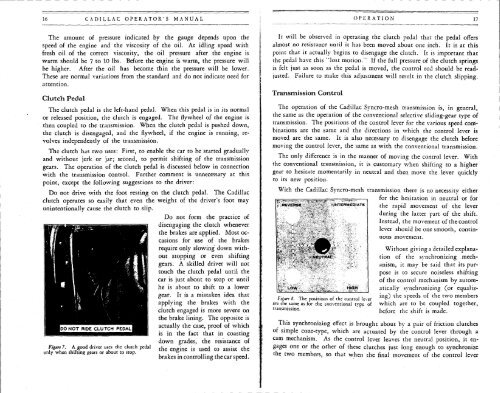1928 Cadillac - GM Heritage Center
1928 Cadillac - GM Heritage Center
1928 Cadillac - GM Heritage Center
You also want an ePaper? Increase the reach of your titles
YUMPU automatically turns print PDFs into web optimized ePapers that Google loves.
16 CADILLAC OPERATOR'S MANUAL<br />
OPERATION 17<br />
The amount of pressure indicated by the gauge depends upon the<br />
speed of the engine and the viscosity of the oil. At idling speed with<br />
fresh oil of the correct viscosity, the oil pressure after the engine is<br />
warm should be 7 to 10 lbs. Before the engine is warm, the pressure will<br />
be higher. After the oil has become thin the pressure will be lower.<br />
These are normal variations from the standard and do not indicate need for<br />
attention.<br />
Clutch Pedal<br />
The clutch pedal is the left-hand pedal. When this pedal is in its normal<br />
or released position, the clutch is engaged. The flywheel of the engine is<br />
then coupled to the transmission. When the clutch pedal is pushed down,<br />
the clutch is disengaged, and the flywheel, if the engine is running, revolves<br />
independently of the transmission.<br />
The clutch has two uses: First, to enable the car to be started gradually<br />
and without jerk or jar; second, to permit shifting of the transmission<br />
gears. The operation of the clutch pedal is discussed below in connection<br />
with the transmission control. Further comment is unnecessary at this<br />
point, except the following suggestions to the driver:<br />
Do not drive with the foot resting on the clutch pedal. The <strong>Cadillac</strong><br />
clutch operates so easily that even the weight of the driver's foot may<br />
unintentionally cause the clutch to slip.<br />
Do not form the practice of<br />
disengaging the clutch whenever<br />
the brakes are applied. Most occasions<br />
for use of the brakes<br />
require only slowing down without<br />
stopping or even shifting<br />
gears. A skilled driver will not<br />
touch the clutch pedal until the<br />
car is just about to stop or until<br />
he is about to shift to a lower<br />
gear. It is a mistaken idea that<br />
applying the brakes with the<br />
clutch engaged is more severe on<br />
the brake lining. The opposite is<br />
actually the case, proof of which<br />
is in the fact that in coasting<br />
down grades, the resistance of<br />
Figure 7. A good driver uses the clutch pedal the engine is used to assist the<br />
only when shifting gears or about to stop.<br />
brakes in controlling the car speed.<br />
It will be observed in operating the clutch pedal that the pedal offers<br />
almost no resistance until it has been moved about one inch. It is at this<br />
point that it actually begins to disengage the clutch. It is important that<br />
the pedal have this "lost motion." If the full pressure of the clutch springs<br />
is felt just as soon as the pedal is moved, the control rod should be readjusted.<br />
Failure to make this adjustment will result in the clutch slipping.<br />
Transmission Control<br />
The operation of the <strong>Cadillac</strong> Syncro-mesh transmission is, in general,<br />
the same as the operation of the conventional selective sliding-gear type of<br />
transmission. The positions of the control lever for the various speed combinations<br />
are the same and the directions in which the control lever is<br />
moved are the same. It is also necessary to disengage the clutch before<br />
moving the control lever, the same as with the conventional transmission.<br />
The only difference is in the manner of moving the control lever. With<br />
the conventional transmission, it is customary when shifting to a higher<br />
gear to hesitate momentarily in neutral and then move the lever quickly<br />
to its new position.<br />
With the <strong>Cadillac</strong> Syncro-mesh transmission there is no necessity either<br />
for the hesitation in neutral or for<br />
REVEfcSE- *,».••*
















